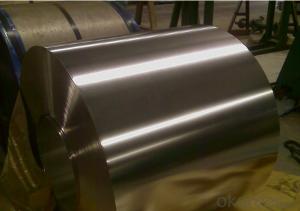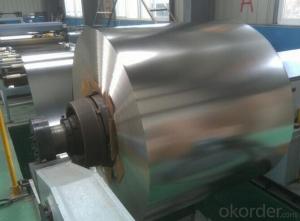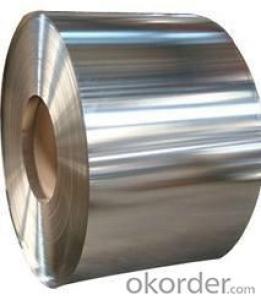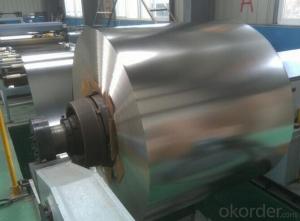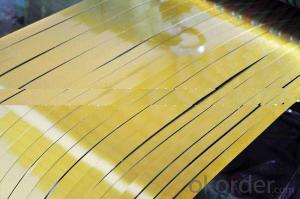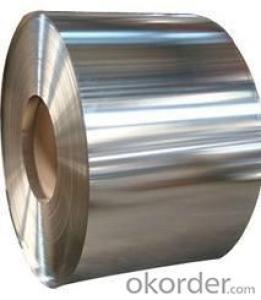Tinplate Coils and Steets for Tin Cans Making
- Loading Port:
- Tianjin
- Payment Terms:
- TT OR LC
- Min Order Qty:
- 25 m.t
- Supply Capability:
- 7000 m.t/month
OKorder Service Pledge
OKorder Financial Service
You Might Also Like
1.Structure of Electrolytic Tin Plate Coils and Sheets for Foods Metal Packaging Description
Electrolytic Tin Plate Coils and Sheets for Foods Metal Packaging, is one thin steel sheet with a coating of tin applied by electrolytic deposition. Tinplate made by this process is essentially a sandwich in which the central core is strip steel. This core is cleaned in a pickling solution and then fed through tanks containing electrolyte, where tin is deposited on both sides. As the strip passes between high-frequency electric induction coils, it is heated so that the tin coating melts and flows to form a lustrous coat.
2.Main Features of the Electrolytic Tin Plate Coils and Sheets for Foods Metal Packaging
Appearance – Electrolytic Tin Plate is characterized by its beautiful metallic luster. Products with various kinds of surface roughness are produced by selecting the surface finish of the substrate steel sheet.
Paintability and printability – Electrolytic Tin Plates have excellent paintability and printability. Printing is beautifully finished using various lacquers and inks.
Formability and strength – Electrolytic Tin Plates have got very good formability and strength. By selecting a proper temper grade, appropriate formability is obtained for different applications as well as the required strength after forming.
Corrosion resistance – Tinplate has got good corrosion resistance. By selecting a proper coating weight, appropriate corrosion resistance is obtained against container contents. Coated items should meet 24 hour 5 % salt spray requirement.
Solderability and weldability – Electrolytic Tin Plates can be joined both by soldering or welding. These properties of tinplate are used for making various types of cans.
Hygienic – Tin coating provides good and non toxic barrier properties to protect food products from impurities, bacteria, moisture, light and odours.
Safe – Tinplate being low weight and high strength makes food cans easy to ship and transport.
Eco friendly – Tinplate offers 100 % recyclability.
Tin is not good for low temperature applications since it changes structure and loses adhesion when exposed to temperatures below – 40 deg C.
3.Electrolytic Tin Plate Coils and Sheets for Foods Metal Packaging Images
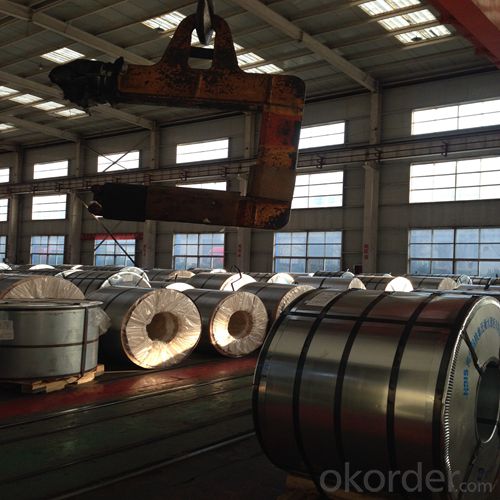
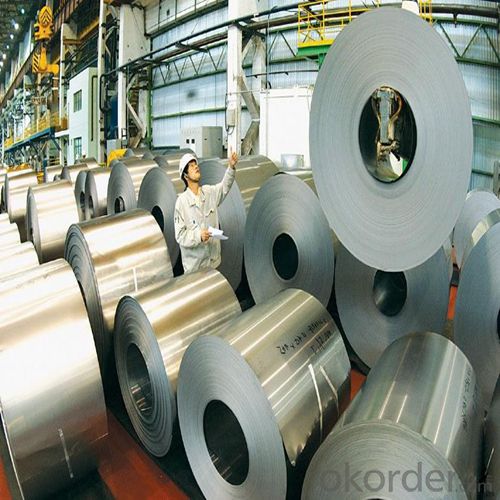
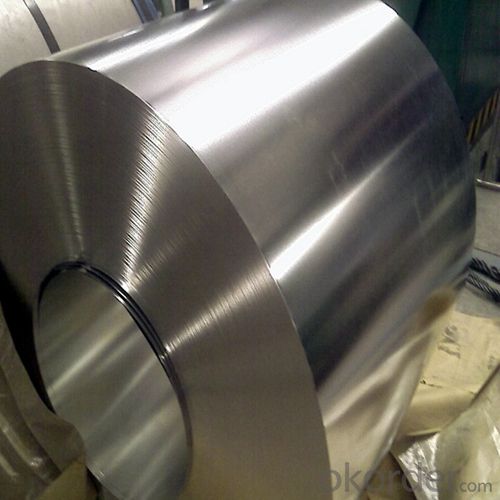
4.Electrolytic Tin Plate Coils and Sheets for Foods Metal Packaging Specification
Standard | ISO 11949 -1995, GB/T2520-2000,JIS G3303,ASTM A623, BS EN 10202
|
Material | MR,SPCC |
Thickness | 0.15mm - 0.50mm |
Width | 600mm -1150mm |
Temper | T1-T5 |
Annealing | BA & CA |
Coil Inner Diameter | 508mm |
Weight | 6-10 tons/coil 1~1.7 tons/sheets bundle |
Passivation | 311 |
Oil | DOS |
Surface | Finish,bright,stone,matte,silver |
5.FAQ of Electrolytic Tin Plate Coils and Sheets for Foods Metal Packaging
-What your tinplate material is used for ?
Tinplate is widely used for the packaging of products. Such as food cans,
beverage cans, pet cans, closures, general line cans and so on.
Printed Tinplate is offered!!
-How to place .an order or contact you ?
Please send us Email. we will give you a quick response in seconds .
- How is your quality ?
All our quality is prime even the secondary quality . We have many years experience
In this field with serious quality control standard . Advanced equipment, We welcome your visit to our factory .
- Q:Are there any limitations to using tinplate packaging?
- Yes, there are several limitations to using tinplate packaging. Firstly, tinplate packaging is relatively expensive compared to other packaging materials such as plastic or cardboard. Additionally, tinplate packaging is heavier and bulkier, which can increase transportation costs. Tinplate is also more susceptible to corrosion, especially in high humidity or acidic environments. Lastly, tinplate is not as flexible as other materials, making it less suitable for certain packaging designs or shapes.
- Q:What are the different forms and shapes tinplate can be manufactured into?
- Tinplate can be manufactured into various forms and shapes, including cans, containers, boxes, trays, and even decorative items. Its malleability allows for complex designs, making it suitable for a wide range of applications in the packaging industry.
- Q:Can tinplate be used for consumer electronics packaging?
- Yes, tinplate can be used for consumer electronics packaging. Tinplate is a durable and corrosion-resistant material that provides excellent protection for electronic devices. It is commonly used for packaging consumer electronics such as smartphones, tablets, and small appliances.
- Q:What are the cost considerations of using tinplate packaging?
- The cost considerations of using tinplate packaging include the price of the tinplate material itself, manufacturing and production costs, transportation and storage expenses, as well as potential additional costs for labeling or customization. Additionally, tinplate packaging may require specialized equipment or machinery for production, which could add to the overall costs. However, tinplate packaging offers advantages such as durability, protection against moisture and air, and its recyclability, which can contribute to overall cost savings in terms of product quality, shelf life, and sustainability.
- Q:What are the different methods of labeling and branding on tinplate packaging?
- There are several methods of labeling and branding on tinplate packaging, including lithography, embossing, printing, and metal etching. Lithography is a popular method that involves applying ink onto the tinplate through a printing process. Embossing creates raised or recessed designs on the surface of the tinplate, adding texture and visual appeal. Printing involves directly printing the design onto the tinplate using various techniques such as screen printing or digital printing. Metal etching is another method where the design is chemically etched onto the tinplate, resulting in a durable and long-lasting branding.
- Q:How does tinplate perform in terms of product protection?
- Tinplate performs exceptionally well in terms of product protection. Its unique properties, including corrosion resistance and durability, make it an ideal choice for packaging solutions. Tinplate provides a reliable barrier against moisture, light, and air, effectively preserving the quality and freshness of the product. Additionally, its strength and rigidity offer excellent physical protection, safeguarding the contents from external impacts during handling and transportation. Overall, tinplate ensures optimal product protection, extending shelf life and enhancing customer satisfaction.
- Q:How is tinplate used in the manufacturing of electronic devices?
- Tinplate is commonly used in the manufacturing of electronic devices as a protective coating for components and circuit boards. It provides corrosion resistance and helps to prevent oxidation, ensuring the longevity and reliability of the devices. Additionally, tinplate is used for solderability, allowing for seamless connections between different parts of the electronic device.
- Q:How is tinplate coated for household appliances?
- Tinplate is coated for household appliances through a process called electrolytic tinning. In this method, a thin layer of tin is deposited onto the surface of the steel plate through an electrolyte bath. The steel plate acts as the cathode, while the tin serves as the anode. The application of an electric current causes tin ions to migrate and bond with the steel, resulting in a durable and corrosion-resistant coating. This tin coating not only enhances the aesthetics of household appliances but also provides protection against rust and improves their overall lifespan.
- Q:Can tinplate be used for packaging cosmetics?
- Yes, tinplate can be used for packaging cosmetics. Tinplate is a popular choice for cosmetic packaging due to its durability, corrosion resistance, and ability to maintain product quality. It provides a protective barrier against external elements, ensuring the longevity of the product. Additionally, tinplate is easily printable, allowing for attractive and eye-catching designs on cosmetic packaging.
- Q:How is tinplate affected by different types of beverages?
- Tinplate is generally resistant to most types of beverages, including acidic ones. However, certain highly acidic or corrosive beverages, such as fruit juices, can cause a chemical reaction with the tin coating, potentially leading to a metallic taste or discoloration. To prevent this, tinplate cans are often lined with a protective coating, such as lacquer or polymer, to ensure the beverage's quality and safety.
1. Manufacturer Overview |
|
|---|---|
| Location | |
| Year Established | |
| Annual Output Value | |
| Main Markets | |
| Company Certifications | |
2. Manufacturer Certificates |
|
|---|---|
| a) Certification Name | |
| Range | |
| Reference | |
| Validity Period | |
3. Manufacturer Capability |
|
|---|---|
| a)Trade Capacity | |
| Nearest Port | |
| Export Percentage | |
| No.of Employees in Trade Department | |
| Language Spoken: | |
| b)Factory Information | |
| Factory Size: | |
| No. of Production Lines | |
| Contract Manufacturing | |
| Product Price Range | |
Send your message to us
Tinplate Coils and Steets for Tin Cans Making
- Loading Port:
- Tianjin
- Payment Terms:
- TT OR LC
- Min Order Qty:
- 25 m.t
- Supply Capability:
- 7000 m.t/month
OKorder Service Pledge
OKorder Financial Service
Similar products
New products
Hot products
Hot Searches
Related keywords
